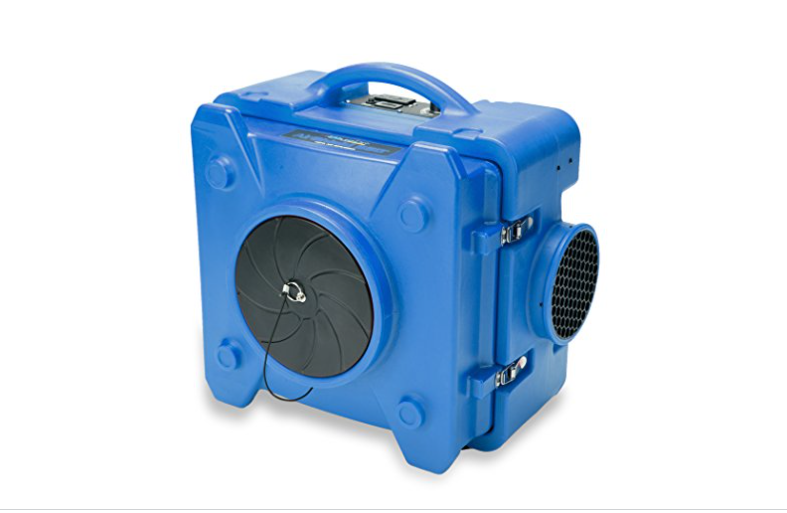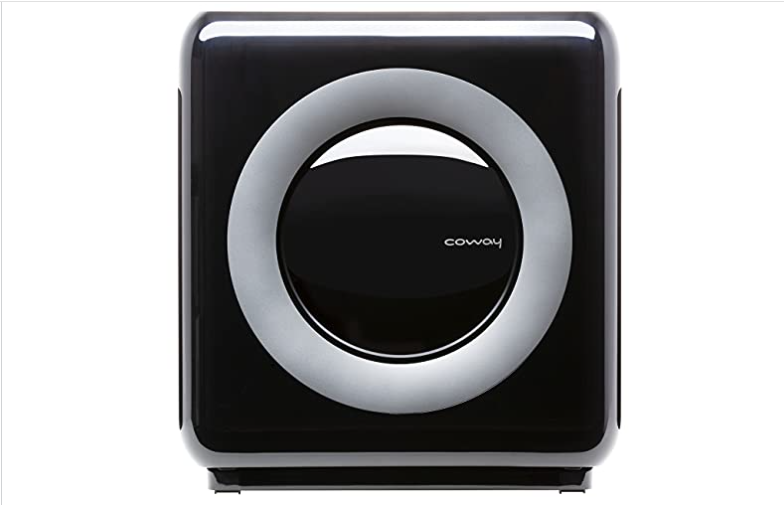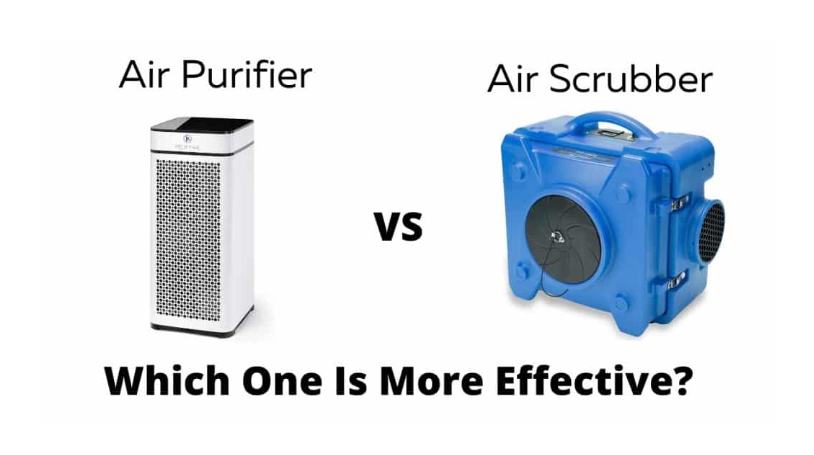Your home should be as clean as possible if you have asthma or another respiratory condition. An air scrubber or air purifier can help you keep your lungs healthy by removing contaminants from your home’s air and preventing them from returning. However, not all air scrubbers and air purifiers are equal – learn air scrubber vs air purifier, and also how to pick the best one for you!
Although the technology behind air scrubbers and air purifiers are similar, the function of the two is vastly different. Here’s everything you need to know about the differences between an air scrubber vs air purifier and how to choose the right one for your needs.
What Is The Purpose Of An Air Purifier?
An air purifier is a device that cleans the air by trapping and killing contaminants within the cleaner. It installed the air purifier directly into your ductwork. Air passes through the machine as it recirculates through your air handler.
An ionization array, which produces both positive and negative ions, is the first component of an air purifier. The polluted air, along with positive and negative ions, is passed through an electrically charged fiber filter material. Like the positive and negative ends, the electrical charge causes the positive and negative ions to separate. Polarization is the term for this process. The ions then attach themselves to the filter’s opposite sides.
The pollutant atoms’ air particles become attracted to both sides of the filter, seeking to join up with positive or negative ions. As a result, the fraction stretches and eventually separates, killing the pathogen. Finally, air passes through a high-MERV filter, which captures any larger particles not destroyed by the electrical ionization process.
So, how effective are air purifiers? Yes, in a nutshell. The air purifier takes in dirty air and exhausts clean air. The atmosphere in your home will become utterly pure after several re-circulations.
What Is The Purpose Of An Air Scrubber?
An air scrubber is a device for cleaning indoor air that uses a search and retrieves method to remove contaminants. The air scrubber continuously produces negative ions as air passes through your ductwork system. They dispatched those negative ions on a mission to locate and return pollutants floating in your air that are too small to be captured by your standard air filter.
When negative ions are present in your home’s air, they seek out positively charged particles such as bacteria, pollen, and other allergens. When negative ions and positive particles combine, they form larger, heavier particles that can no longer float. Instead, they drop to the earth or land on objects. When the fan on your air handler turns on, it pulls the newly formed, larger dirt particles through your ductwork system, eventually landing on and sticking to your air filter.
- An Air Scrubber uses small metal tubes to produce negative ions. A special coating applies to the tubes in a honeycomb pattern. The air travels through the tubes before passing through a section with ultraviolet (or UV) light. As a result, it creates negative ions that clean your air.
- You may notice an increase in the dust around your home during the first week of operation while the air scrubber is cleaning the air in your home. It can be swept, vacuumed, or wiped up.
- Consider it a once-over spring cleaning. You shouldn’t notice much dust after the first operation.
- The air scrubber produces ions that do the heavy lifting within your home’s spaces, with dirt and particles eventually settling on your air handler’s filter.
What Is The Function Of An Air Purifier?
Think of an air purifier operating in the background to understand the difference between an air purifier and an air scrubber.
Air purifiers usually have a fan that blows air at a high rate through the unit. The air will then pass through one or more filters, which will filter out dust, dirt, pollen, and other airborne pollutants.
One or more of these filters are usually found in air purifiers, each with its function:
- Pre-filters will aid in the removal of larger airborne particles such as dust. As a result, pre-filters lighten the load on subsequent filters, resulting in fewer filter replacements overall.
- Some air purifiers have washable filters that remove larger particulates missed by the pre-filters. It helps remove coarse dust particles from the air. As they’re washable, they’re also simple to maintain.
- High-end air purifiers use HEPA (High-Efficiency Particulate Arrestance) filters. These filters remove pollutants as small as 0.3 microns from the air.
- It can remove 99.97 percent of these particulates, including bacteria and viruses-carrying water droplets. Clinics frequently use HEPA filters because they are a less expensive alternative to hospital-grade air purifiers.
- Some air purifier models also have an activated carbon filter. These filters are typically used to eliminate foul odors from the air.
What Goods in Air Purifier?
An air purifier can remove dust and pollen, but it can also remove germs and viruses. Although there are many options, a good air purifier will include most of the filters listed below.
They found most air purifiers in your HVAC system. It means they take up no additional space in your home. We recommend replacing these filters once or twice a year as they are suitable for indoor use. It includes a HEPA filter for carbon filters and UV light.
Although you can add carbon filters to some air scrubbers, most air purifiers can remove odors and gases from the air inside your home. Furthermore, air purifiers are inexpensive enough for home use. So, an air purifier is a device that plugs into your HVAC system and purifies the air inside your home by removing dust, pollen, bacteria, viruses, and odors. It is also available as a portable device and is less expensive.
What Bad in Air Purifier?
Clean Airborne Particles only. Only pollutants and airborne particles have a chance of getting caught in air purifier filters due to their cleaning mechanism. It means that impurities adhered to household surfaces such as floors and walls will not pass through the air purifier’s multiple filters.
It must replace filters. The air purifier‘s filters collect dust, dirt, pollen, and other pollutants. As a result, the filters will become clogged and ineffective at purifying the air. As a result, users will have to purchase new filters, incurring an additional financial cost.
Regular filters are usually inexpensive, but HEPA filters are more expensive. It will increase the total cost of running the air purifier.
Aside from that, some air filter replacements are difficult to come by, if not impossible. It is especially true for brands and models that are eventually phased out, forcing users to look for third-party replacements or completely replace their air purifiers.
What Is The Function Of An Air Scrubber?
The workings of air scrubbers and air purifiers are pretty similar. However, rather than passively cleaning whatever airborne particles its filters can catch, an air scrubber works more actively to clean the air.
Most air scrubbers produce negative ions dispersed throughout the home. Negative ions bind to particulates and pollutants in the air and surfaces, such as doors, walls, and mirrors. When smaller particles fly scrubber’s filters, it is much easier to catch them.
More advanced air scrubbers may use wet scrubbing, which forces air through a pool of water to trap particulates. The water effectively scrubs the air and keeps it free of pollutants. This type of air scrubber, on the other hand, is more commonly found in industrial appliances than in-home solutions.
What Goods in Air Scrubber?
The improved indoor air quality is the most apparent benefit. An air scrubber cleanses the air to remove toxic gases and chemicals. It is beneficial if you live near an industrial area or on a busy street. You won’t have to worry about gases from a car’s exhaust or dusty air.
It also can remove mold spores and other allergens from the air. As a result, people with asthma and other respiratory issues, such as mold allergies can breathe easier.
Although air scrubbers are most commonly found in commercial buildings, you can get one for your home. They are available in smaller sizes and at lower prices for home use. Furthermore, you can install them directly in your HVAC system!
- It is a portable device
- It can clean large areas with a single unit.
- Rids the air of pollutants and chemical gases
- Don’t produce ozone
- It comes in various types
- It can install in an HVAC system too
What Bad in Air Scrubber?
Air scrubber disadvantages include being more expensive than air purifiers. Because of the additional components and mechanisms used, air scrubbers are more costly than regular air purifiers. Given how much more effective it is at improving indoor air quality, the cost is justified.
The higher price tag may be much more than the buyer can afford. A less expensive air purifier may be a better option in those cases.
Because it adheres to surfaces, it is necessary to vacuum and wipe the pollutants away wholly. The air scrubber’s negative ions will do an excellent job sticking to contaminants in the air and on surfaces. Some of the pollutants will be heavy enough to be carried into the filters by air, while others will stick to the characters. Those pollutants will remain until vacuumed, mopped, or manually wiped away.
Which Person Should Use An Air Purifier?
Because air purifiers trap smaller particles that can harm your breathing space and create contaminated air, they are best for people with allergies or respiratory problems.
A whole-house air purifier with HEPA filters effectively removed allergens, pet dander, dust, odors, bacteria, and harmful air chemicals. An air purifying device will benefit people with asthma or other respiratory conditions. Using a whole-house air purifier can help alleviate allergy and asthma symptoms while also cleaning the air. Furthermore, the most cost-effective way to improve air quality is to use one air purifier per room.
Which Person Should Use An Air Scrubber?
Indoor spaces, warehouses, and other commercial areas are best cleaned with air scrubbers. Portable air scrubbers assist in the removal of toxic and harmful contaminants from the air. Professionals commonly use air scrubbers to reduce odors and fumes during mold remediation, renovations, and painting.
An air scrubber is the most effective way to remove mold spores from the air. The harmful particles in the scrubber attach to mold spores in the air and kill them inside the scrubber. Imagine using an air scrubber in a mold-free area. It will aid in lowering the total number of spores in the air, preventing future outbreaks.
An air scrubber is ideal for removing chemical vapors, odors, and gases from a room’s atmosphere and disinfecting it. However, they are less effective at removing allergens and larger particles from the air. An air scrubber is the most effective way to clean a room quickly for your health and well-being. However, if you have allergies or respiratory problems, an air-purifying device may be better.
When deciding which one to purchase, use your common sense. If you have small children or pets who lack air purifier filters could harm, buy one to protect your family and pets.
Which One Is the Best between Air scrubber vs Air Purifier?
Air purifiers and air scrubbers use ionization chemistry to clean the air. Both devices will thoroughly clean your air, removing up to 99 percent of airborne particles. If you want to purify the air in your home, either option will suffice.
An air purifier can complete the cleansing process within the device. After installation, pure air exits the machine, delivering clean, fresh air to your space. On the downside, replacing the high-efficiency MERV filter with an air purifier will require regular maintenance. Filters with a higher MERV rating, such as those found in air purifiers, will cost more than air handlers’ more common air filters.
So, in comparison of air scrubber vs air purifier, the air scrubber has no components that need to be replaced regularly–it’s set and forget. While the cleansing work done in your space rather than within the device may unsettle, the air scrubber has a significant advantage. The negative ions will attach to particles on surfaces in your home, such as countertops, doorknobs, and light switches. An air purifier can clean only airborne particles. An air scrubber is a way to go if you want clean air and clean surfaces.
1 – BlueDri BD-AS-550-BL – Best in Air Purifiers
BlueDri BD-AS-550-BL

Key Features:
- 14 x 25 x 20 inches in size
- Electric power source with a cord
- 41.2-pound weight
- Filter 3-Stage
- 250 to 500 CFM
- Amps 2.5
- 7.5″ outlet diameter
- 1/3 horsepower motor
- 11.5 inlet diameter
- Power 115V/60HZ
Pros
- It captured large particles.
- It has a large dust capacity.
- Durable and powerful air purifier machine.
Cons
- It’s a little noisy.
- Filter replacements are a little pricey.
The BlueDri BD-AS-550-BL air scrubber is the best option to remove harmful contaminants from your home. It’s a negative air machine that cleans your house of smoke, pet dander, asbestos, pollen, dust, and other pollutants.
It’s a powerful machine with HEPA filters that can remove up to 99.97 percent of air contaminants in your home. This air scrubber will help purify the air of harmful particles that cause allergic reactions if you have them frequently.
If you need one for construction, remodeling, or restoration projects, the BlueDri BD-AS-550-BL air scrubber might be what you’re looking for. It includes a carbon filter that removes odors from cleaning products, paint, and salon tools (on request).
If you want a breath of fresh air in your home, this is the best home air scrubber.
2 – Coway AP-1512HH – Best in Air Scrubber
Coway AP-1512HH

Key Features:
- 9.6 x 16.8 x 18.3 inch dimensions
- Electric Power Source with a Cord
- 12.3-pound weight
- It can remove 99.84% of the particles in one hour
- CADR 240
Pros
- Excellent air cleaning ability.
- Operation in silence.
- Cost over a lifetime.
Cons
- High initial investment.
The Coway AP-1512HH comes in second place in terms of performance. It removed 99.84 percent of the measurable airborne particulates from our testing room in an hour. While it falls short of our highest-ranked model by a few decimals, this is still an excellent performance. The fans on this machine are powerful enough to circulate cool air while remaining quiet enough not to interfere with your evening Netflix binge. The built-in air quality monitor is both practical and precise.
This unit has a higher initial cost than most other models we tested, but there is a catch. Thankfully, the Coway is one of the most cost-effective air purifiers. It has long-lasting filters and consumes very little electricity. It is a high-quality device that is slightly less expensive than our top pick.
Conclusion
It is challenging to choose one because of all the conflicting information on the Internet about air scrubbers vs air purifiers. A comparison of air scrubbers vs air purifiers based on the size of a home or office. The number of people in it and how much you want to spend on this necessary household item, this guide will undoubtedly assist you in deciding whether an air scrubber or an air purifier is better for you.
Frequently Asked Questions
Is an air purifier required if I have an air scrubber?
A: If you want to eliminate fine particles, you need a true HEPA filter or better. It includes mold spores, dust, pollen, or tobacco smoke particles.
How long should an air scrubber be helpful?
A: According to industry guidelines, an air scrubber should be in the environment for 24 to 48 hours. These air exchange devices typically perform 4 to 6 air exchanges per hour, assisting in the filtration and cleaning of the airspace.
Is it a helpful air purifier for coughing?
A: Air filtration may help reduce the adverse health effects of air pollutants, such as respiratory illnesses, coughing, wheezing, and mucous membrane irritation. Using an air filtration system with a HEPA filter can reduce dust, mold, and pollen allergies.
Are air purifiers beneficial to the lungs?
A: If you live in an area with a lot of pollution or seasonal wildfires, an air purifier can help. Room air cleaners may even help people with COPD who share their home with pets breathe a little easier. Air purifiers may reduce cytokines, which are cell proteins linked to inflammation.
Can you get sick from using an air scrubber?
A: A few symptoms of air purifiers can include headaches, asthma attacks, and difficulty breathing. That is correct. Your air purifier is helping you deal with many of your health issues.
